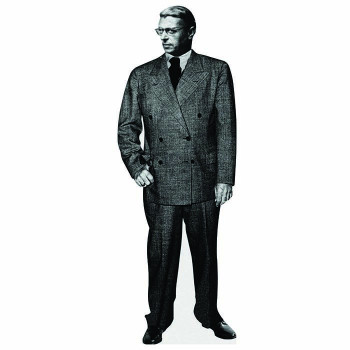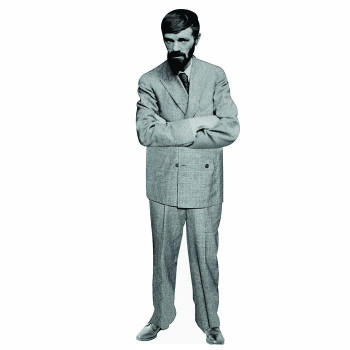EUGENE O NEILL CARDBOARD CUTOUT
-
$0.00
Available Options
Buy Instantly With
Introduction to Eugene O Neill
Celebrate the legacy of one of America's greatest playwrights with our lifesize cardboard cutout of Eugene O'Neill. Perfect for theatrical displays, educational events, or as an inspiring addition to your home or office, this cutout captures the intense and contemplative presence of Eugene O'Neill, reflecting his profound impact on American drama and theatre.
Background of Eugene O Neill
Eugene Gladstone O'Neill was born on October 16, 1888, in New York City. The son of James O'Neill, a popular actor, and Mary Ellen Quinlan, O'Neill was exposed to the world of theatre from a young age. His early life was marked by turbulence and personal struggles, including his mother's addiction to morphine and his own battle with tuberculosis.
After attending Princeton University briefly, O'Neill spent several years drifting and working various jobs, including as a sailor. During this period, he experienced the harsh realities of life, which would later inform his writing. In 1912, O'Neill was diagnosed with tuberculosis and spent time recovering in a sanatorium, where he began to write plays.
O'Neill's early works, including "Bound East for Cardiff" (1916) and "The Long Voyage Home" (1917), were produced by the Provincetown Players, a group dedicated to experimental theatre. His breakthrough came with "Beyond the Horizon" (1920), which won the Pulitzer Prize for Drama and established him as a major force in American theatre.
Throughout his career, O'Neill wrote numerous plays that explored complex themes such as family dynamics, personal redemption, and existential despair. His most famous works include "The Iceman Cometh" (1946), "A Moon for the Misbegotten" (1947), and "Long Day's Journey Into Night" (1956), a deeply autobiographical play that was published posthumously and earned him a fourth Pulitzer Prize.
O'Neill's innovative use of realism, symbolism, and expressionism helped to transform American theatre. His willingness to tackle difficult and often taboo subjects set a new standard for dramatic literature.
Despite his professional success, O'Neill's personal life was fraught with difficulties, including multiple marriages and ongoing health issues. He passed away on November 27, 1953, in Boston, Massachusetts, but his legacy as a pioneering playwright endures.
Cultural Impact of Eugene O Neill
Eugene O'Neill's impact on American drama and theatre is profound and enduring. Often regarded as the father of American drama, O'Neill's plays broke new ground in their exploration of human psychology and social issues. His works introduced a level of emotional depth and complexity that had been largely absent from American theatre.
O'Neill's innovative use of stagecraft, including his integration of realistic dialogue and experimental techniques, influenced subsequent generations of playwrights. His willingness to delve into the darker aspects of the human experience paved the way for later playwrights such as Tennessee Williams, Arthur Miller, and Edward Albee.
"Long Day's Journey Into Night," considered O'Neill's masterpiece, is a raw and unflinching portrayal of his own family’s struggles. The play's exploration of addiction, guilt, and the search for redemption resonates with audiences and critics alike, earning it a place among the greatest works of American literature.
O'Neill's other major works, such as "The Iceman Cometh" and "A Moon for the Misbegotten," continue to be performed and studied for their rich character development and profound thematic content. His ability to capture the complexity of human emotions and relationships has made his plays timeless.
In recognition of his contributions to literature and theatre, O'Neill was awarded the Nobel Prize in Literature in 1936, the first American playwright to receive the honor. His influence extends beyond the stage to film and television adaptations of his works, which have brought his powerful narratives to a broader audience.
Eugene O'Neill's legacy is celebrated through various institutions, including the Eugene O'Neill Theater Center in Waterford, Connecticut, which supports the development of new plays and playwrights. His works continue to inspire and challenge actors, directors, and audiences, ensuring that his voice remains a vital part of the theatrical tradition.
This cutout of Eugene O'Neill celebrates his remarkable contributions and enduring legacy as a master playwright. It serves as a tribute to his literary brilliance, his impact on American drama, and his significant role in shaping the theatre landscape.
| Size | |
| Width | 19 Inches |
| Height | 71 Inches |
- Brand: Historical Cutouts
- Product Code:H79051
- Availability:In Stock
LEARN MORE ABOUT OUR AVAILABLE MATERIALS

LIFE SIZE HISTORICAL CUTOUTS
We have been the leading historical based cutout supplier for nearly 10 years. We have worked with many schools, museums, and colleges across the country to provide stunning graphics from hsitory. Historical Cutouts are available in 3 materials and come contour cut with an easel to be self standing. Click below to learn more about each material and our cutout process.
Learn More
LIFE SIZE HISTORICAL WALL DECALS
All of our historical figures are available as a life size wall decals. Vinyl wall decal orders come ready to apply with squeegie and instructions. Having trouble? Check out our how to youtube video. Our graphics are printed on tear resistant PhotoTex Vinyl using our high definition 4 color plus white printing process.
Learn More
HISTORICAL ACRYLIC CUTOUTS
Desktop Legends are a smaller version of our life size cutotus printed on 3/16th" acrylic. All of our historical cutouts are also available as a desktop legend. These acrylic statuettes come in two sizes, 8" and 12". If you would like to learn more please click below.
Learn MoreRELATED PRODUCTS
-
Jean-Paul Sartre Cardboard Cutout
Introduction to Jean-Paul SartreCelebrate the legacy of one of the most influential existentialist p..
Vincent Van Gogh Cardboard Cutout
Introduction to Vincent Van GoghCelebrate the legacy of one of the most iconic and influential artis..
Claude Monet Cardboard Cutout
Introduction to Claude Monet Cardboard CutoutCelebrate the legacy of one of the most influential fig..
Franz Schubert Composer Cardboard Cutout
Introduction to Franz SchubertImmerse yourself in the timeless beauty of classical music with our Fr..
AA Milne Cardboard Cutout
Introduction to AA MilneAre you a fan of timeless literary classics and nostalgic childhood tales? B..
Paul Gauguin Cardboard Cutout
Introduction to Paul GauguinCelebrate the legacy of one of the most innovative and influential artis..
William James Cardboard Cutout
Introduction to William JamesCelebrate the legacy of one of America's most influential philosophers ..
Charles Dickens Cardboard Cutout
Introduction to Charles DickensCelebrate the legacy of one of the greatest novelists in English lite..
Titan of Space and Time Super Hero Cardboard Cutout
Introduction to Titan of Space and Time Super HeroStep into the world of superhero legend with the T..
Charles J Guiteau Cardboard Cutout
Introduction to Charles J GuiteauExplore the dark and infamous legacy of one of American history’s m..
D. H. Lawrence Cardboard Cutout
Introduction to D. H. LawrenceCelebrate the legacy of one of the 20th century's most controversial a..
Rabindranath Tagore Cardboard Cutout
Introduction to Rabindranath TagoreCelebrate the legacy of one of the most influential literary figu..














